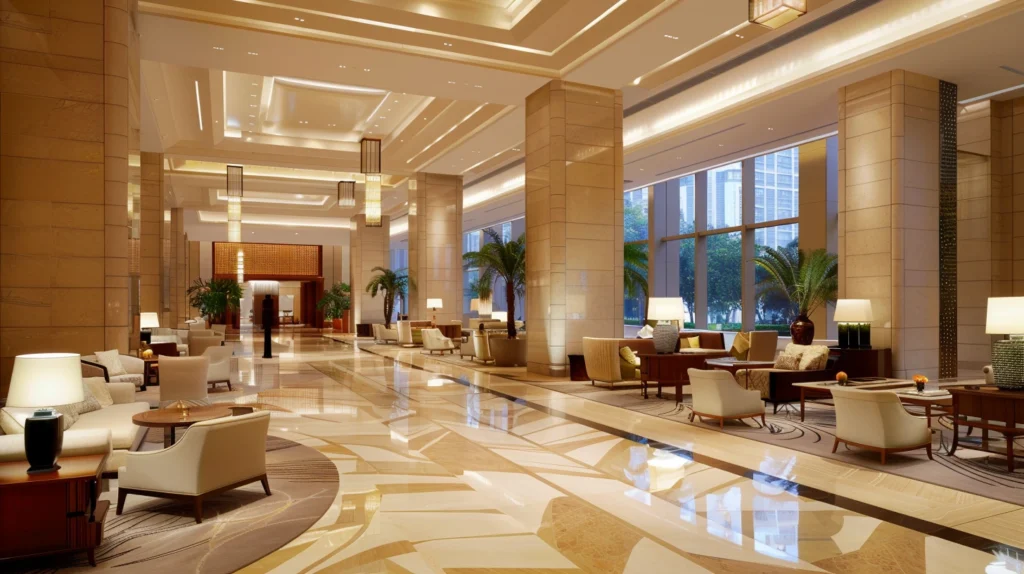1. Introduction: Evolving Demands in Hospitality Spaces

Hospitality environments are evolving rapidly in response to new guest expectations. Post-pandemic, travelers seek comfort, safety, and emotional connection—all of which can be expressed through thoughtful furniture design. In 2025, hospitality furniture is no longer just functional; it’s a key part of creating immersive guest experiences. This guide explores the most important trends shaping furniture design, materials, and sourcing strategies in the hospitality sector.
2. Design Trends: Blending Function & Emotion

Hospitality spaces are shifting from rigid layouts to more fluid, home-like environments. Leading design directions include:
- Soft Minimalism & Curved Forms – Clean lines with softened edges bring a sense of calm and sophistication. Curved sofas, round tables, and organic shapes are replacing sharp corners.
- Residential Comfort in Commercial Interiors – Hospitality furniture is adopting home-inspired designs with plush textures and layered accents, enhancing guest relaxation.
- Color Revival – Earthy tones like sage green, warm beige, and walnut are trending, replacing sterile grays with more welcoming palettes.
- Modular and Multi-functional Furniture – From movable lounge units to convertible workstations, furniture needs to adapt quickly to different uses in boutique hotels and serviced apartments.
3. Material Trends: Sustainable & Sensory

Materials in hospitality furniture now focus on both performance and emotional impact:
- Natural Textures – Rattan, cane, linen, and solid wood veneers add visual warmth and tactile appeal.
- Eco-Friendly Surfaces – E1/E0 low-formaldehyde boards, FSC-certified timber, and recycled textiles are becoming industry standards.
- Metal Meets Organic – Combining black or brass metal frames with soft fabrics or natural wood surfaces creates a modern yet inviting contrast.
- Smart Finishes – Anti-microbial, stain-resistant, and easy-clean coatings enhance durability without sacrificing comfort.
4. Sourcing Trends: From Mass to Bespoke

Procurement methods are shifting to better suit modern hospitality projects:
- Low MOQ, High Customization – Small-batch and made-to-order production allow for tailored solutions in themed hotels or boutique properties.
- Hybrid Sourcing Models – A blend of local fabrication (for speed) and international sourcing (for pricing or specialties) helps meet both budget and design intent.
- 3D Visualization and Virtual Prototyping – Faster design iterations with fewer physical samples shorten the decision cycle.
- Sustainability as a Standard – Clients now require proof of eco-certifications, energy-efficient production, and ethical labor practices.
5. Regional Highlights: Global Style Directions
Different regions are shaping their own distinctive furniture trends:
- Europe – Sustainable design leads with minimalist, timeless forms and responsible material sourcing.
- Middle East – Luxury reigns with detailed craftsmanship, rich veneers, brass accents, and bespoke finishes.
- Southeast Asia – Embracing tropical aesthetics with teak, bamboo, and open-air inspired designs, especially in resort furniture.
- United States – Emphasis on ergonomic comfort, durable upholstery, and modular systems suited for hybrid spaces.
6. Conclusion: Stay Ahead in 2025
Hospitality furniture plays a vital role in shaping guest experiences. As comfort, sustainability, and personalization continue to drive decisions in 2025, successful buyers will partner with manufacturers who can deliver design flexibility, eco-conscious materials, and customized service. At BOKE Furniture, we’re here to support your next hospitality project with tailored solutions and full project support.
Need trend-aligned hospitality furniture? Contact us today to explore catalogs or request a custom quote.
